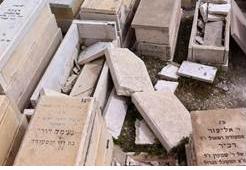 Yerushalayim…It has been more than three years since the idea of constructing a wall around parts of Har Hazeisim was first raised by leaders of the International Committee on the Preservation of Har Hazeisim (ICPHH). On Sunday, contractors began the process of constructing a wall and fence around the Eastern section of Har Hazeisim, which includes such chelkas as Poilen, Taiman, Ger, Afghanistan and Agudas Achim. Several of these sections were frequently targeted by Arab vandals who desecrated graves and attacked visitors with stones. Thanks to stepped up security, including the installation of additional surveillance cameras, a robust police presence, and the stationing of border police, there have been few incidents since October 2015.
Yerushalayim…It has been more than three years since the idea of constructing a wall around parts of Har Hazeisim was first raised by leaders of the International Committee on the Preservation of Har Hazeisim (ICPHH). On Sunday, contractors began the process of constructing a wall and fence around the Eastern section of Har Hazeisim, which includes such chelkas as Poilen, Taiman, Ger, Afghanistan and Agudas Achim. Several of these sections were frequently targeted by Arab vandals who desecrated graves and attacked visitors with stones. Thanks to stepped up security, including the installation of additional surveillance cameras, a robust police presence, and the stationing of border police, there have been few incidents since October 2015.
“When we first raised the idea, we got significant push back from many people for a variety of reasons but as time went on it became a national consensus that the holiest cemetery and revered mountain should be protected by walls and fences,” said Avrohom Lubinsky, chairman of the ICPHH. The idea was first raised by Avrohom’s brother Menachem who argued at Knesset hearings that “it is unfathomable that a cemetery containing 150,000 neshomos, including some of our most celebrated historic figures dating back to the Nevi’im should not be protected by a wall as most cemeteries throughout the world are.”
After extensive lobbying, the committee managed to convince both the municipal and national governments to finance the wall with an estimated cost of NIS 3.5 million. Thanks to the efforts of Deputy Mayor Yossie Deutsch,NIS 1.5 million was authorized by the City Council and Mayor Nir Barkat for the wall. On the national level, the wall was strongly supported by the Netanyahu administration. Thanks to MK Moshe Gafni, Chairman of the Knesset Finance Committee, an additional NIS 2 million was allocated for the wall by the national government.
According to police officials, the wall will significantly contribute to the security of Har Hazeisim. It will limit the possibility of incursions by vandals and allow for better policing on the mountain itself. In addition to the wall, additional surveillance cameras, now numbering 173, as well as new lighting will also be added.
The ICPHH is also focused on a broad range of projects including the restoration of 23,000 graves destroyed during the Jordanian occupation (1948-1967) and the construction of a Visitors Education Center. “We have turned the corner with the upgraded security which is clearly evidenced by the dramatic increase of visitors from an average 300 a day in 2015 to 1300 today,” said Mr. Lubinsky. He added: “We dare not return to the era prior to 2010 when the ICPHH was founded and when Har Hazeisim was full of desecrated graves, strewn garbage, donkey races, drug infestation, and routine stoning of visitors,” Mr. Lubinsky added.





